
views
Remove leaves, water, and other debris from your roof.
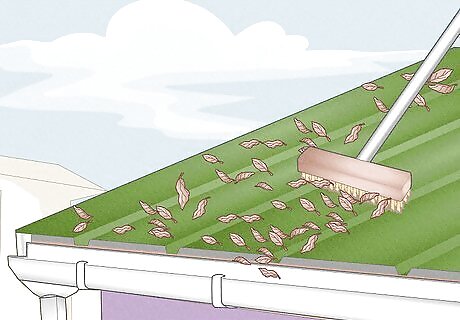
Use a 5% mix of sodium hypochlorite to clean your roof. Debris like leaves and water can damage your roof and eventually lead to corrosion. To clean, apply the solution to your roof and let it sit for 20 minutes. After, wash the roof's surface with a water hose. Usually, one treatment will be enough to remove the debris. If not, try another round of treatment. Inspect your roof at least once a season to see if it needs cleaning. When climbing up and down your ladder, keep 3 points of contact (at least one hand and both your feet) on the ladder at all times. Be very careful when you stand on the roof! As you walk, stay near the metal bolts. These provide sturdier ground. If you're at all nervous about keeping your balance, consider hiring a professional to clean your roof instead.
Sweep snow and ice from your roof when it accumulates.

Use a long-handled broom or brush for this method. You can also use a tool called a roof rake. Sweep as much snow or ice off the roof as you can so that your roof doesn't have to carry such a heavy load. It's important to do this before the snow or ice melts, as water can pool on your roof and cause rust or corrosion of the material. Use extreme caution if cleaning snow or ice from a roof with a metal tool, as it may scrape and damage the protective coating of the roof.
Clean the gutters at least 3 times a year.

This helps you avoid leaks and water damage on your roof. Starting at the downspout, position your ladder against your roof and clean from the ladder. This is much safer than standing on your roof. Next, use a gutter scoop to remove the leaves and other debris. If anything is lodged or stuck in your gutter, use a water hose to apply pressure and force out the debris. Once everything is cleared, run the hose over the gutters to flush out any lingering debris! You can also make a gutter scoop out of an old container, like a plastic jug. Wear gloves to keep your hands protected and clean. You may need to clean your gutters more often if your house is surrounded by trees.
Seal any leaks in your gutters.
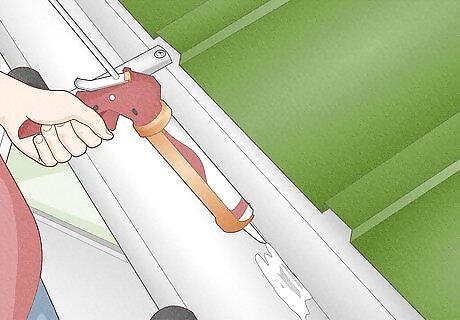
Holes or vulnerable spots in your gutters can lead to water damage. After cleaning your gutters, wait for them to dry. Next, use butyl-based gutter caulk to fill any holes on the inside of your gutter. Plugging up any holes in your gutters will prevent water from dripping onto your roof and home and the potential corrosion that would cause. Make sure to do this after you've already cleaned your gutters! You can't apply the caulk efficiently when dealing with debris or old caulking material stuck to the gutters.
Trim branches near your roof to avoid falling debris.

Leaves and overhanging branches provide a perfect habitat for algae. Moss and algae like the shade and falling leaves trees provide. You can prevent algae from spreading all over your roof by maintaining the trees and branches close to your home. Cut any branches so that they don't hang over your roof, and trim nearby bushes and plant life so that they aren't touching your roof and gutters.
Fix scratches before they spread.
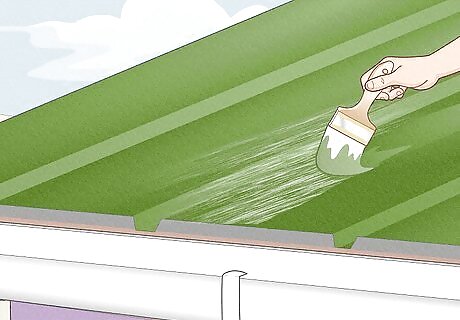
Use touch-up paint to cover up any damage. Inspect your roof for scratches regularly and cover-up new ones as soon as they appear. Scratches can spread and cause corrosion over time, so it's best to deal with them as soon as possible. Use a paint pen made by the metal manufacturer of your roof. This can help you get the best color match! You can also use a small paintbrush and metal touch-up paint to cover the scratched area.
Keep different types of metals separate.
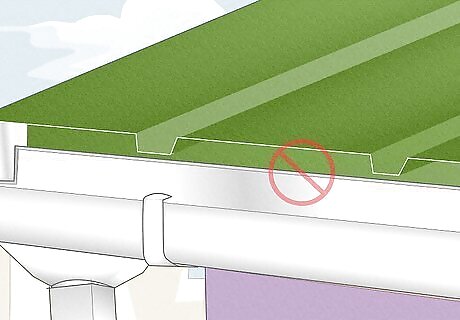
Installing dissimilar metals together can cause corrosion over time. The most popular types of metal used for roofing are steel, aluminum, and copper. When installing or repairing your roof, don't use multiple types of metal or allow them to have contact with each other. For example, installing a steel roof with a copper gutter system will eventually lead to corrosion and damage. Use like materials when repairing or installing your roof. The materials don't even have to be in direct contact to cause damage. When water from a copper pipe or gutter splashes or drips onto a steel roofing system, it can cause the metals to corrode.
Invest in a tarp to prepare for bad weather conditions.

This is a dependable, temporary fix in case of emergencies. After extreme weather events like hurricanes or tornados, check your roof for any damage. If fallen trees or debris damage a portion of your roof during the storm, cover the area with a tarp. This helps you avoid further damage to the rest of your roof and the inside of your home. After bad weather, check for accumulation of water and clogs in the gutters. Though it's always best to be on the safe side, metal roofs are able to withstand extreme weather better than other materials. They can handle 140 miles (230 km) per hour winds and heavy rainfall without damage.
Call a professional if you notice a leak in your roof.
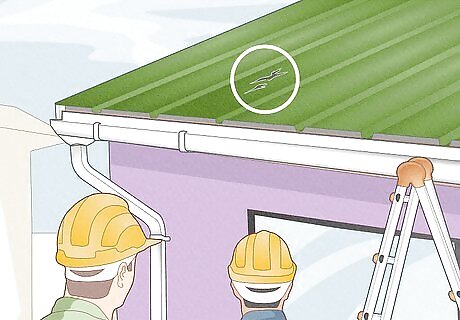
A professional roof contractor will have adequate tools and experience. Because of the dangers of installing a metal roof and the experience it requires to do the job right (you don't want to waste money on a costly repair done wrong), it's best to leave this part to a professional. Ask friends or relatives if they have recommendations, or check online for reputable contracting companies with verified, positive reviews.




















Comments
0 comment